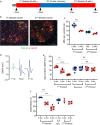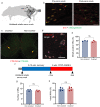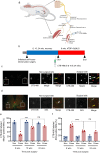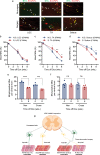Slow motor neurons resist pathological TDP-43 and mediate motor recovery in the rNLS8 model of amyotrophic lateral sclerosis
- PMID: 35568882
- PMCID: PMC9107273
- DOI: 10.1186/s40478-022-01373-0
Slow motor neurons resist pathological TDP-43 and mediate motor recovery in the rNLS8 model of amyotrophic lateral sclerosis
Abstract
In the intermediate stages of amyotrophic lateral sclerosis (ALS), surviving motor neurons (MNs) that show intrinsic resistance to TDP-43 proteinopathy can partially compensate for the loss of their more disease-susceptible counterparts. Elucidating the mechanisms of this compensation may reveal approaches for attenuating motor impairment in ALS patients. In the rNLS8 mouse model of ALS-like pathology driven by doxycycline-regulated neuronal expression of human TDP-43 lacking a nuclear localization signal (hTDP-43ΔNLS), slow MNs are more resistant to disease than fast-fatigable (FF) MNs and can mediate recovery following transgene suppression. In the present study, we used a viral tracing strategy to show that these disease-resistant slow MNs sprout to reinnervate motor endplates of adjacent muscle fibers vacated by degenerated FF MNs. Moreover, we found that neuromuscular junctions within fast-twitch skeletal muscle (tibialis anterior, TA) reinnervated by SK3-positive slow MNs acquire resistance to axonal dieback when challenged with a second course of hTDP-43ΔNLS pathology. The selective resistance of reinnervated neuromuscular junctions was specifically induced by the unique pattern of reinnervation following TDP-43-induced neurodegeneration, as recovery from unilateral sciatic nerve crush did not produce motor units resistant to subsequent hTDP-43ΔNLS. Using cross-reinnervation and self-reinnervation surgery in which motor axons are disconnected from their target muscle and reconnected to a new muscle, we show that FF MNs remain hTDP-43ΔNLS-susceptible and slow MNs remain resistant, regardless of which muscle fibers they control. Collectively, these findings demonstrate that MN identity dictates the susceptibility of neuromuscular junctions to TDP-43 pathology and slow MNs can drive recovery of motor systems due to their remarkable resilience to TDP-43-driven degeneration. This study highlights a potential pathway for regaining motor function with ALS pathology in the advent of therapies that halt the underlying neurodegenerative process.
Keywords: Amyotrophic lateral sclerosis; Cross-reinnervation surgery; Neurodegeneration; Neuropathology; TDP-43; rNLS8.
© 2022. The Author(s).
Conflict of interest statement
John Q. Trojanowski was a member of the Editorial Board of Acta Neuropathologica. The authors declare that they have no competing interests. Krista J. Spiller is an employee of Janssen R&D, the pharmaceutical company of Johnson & Johnson.
Figures






References
Publication types
MeSH terms
Substances
Grants and funding
LinkOut - more resources
Full Text Sources
Other Literature Sources
Medical
Miscellaneous

